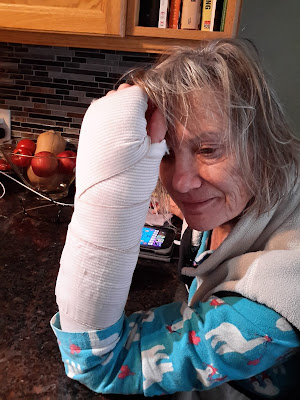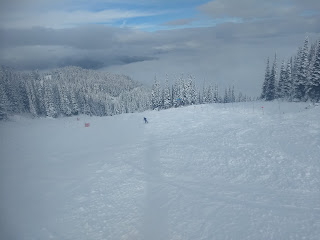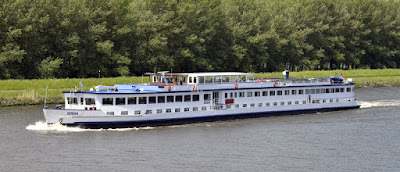 |
| On top of the Shöttelkarspitze (Mittenwald in the distance) |
We have posted all of our Bavaria trip photos on an album on our FLICKR account
here.
After the Netherlands bike and boat trip, we took the train south to the Bavarian alps to Mittenwald, with a one night stopover in Nuremburg.
With only one night in
Nuremburg, we could only (barely) get a taste for the city. What we saw we very much liked. Its old town (rebuilt after its destruction in the Second World War) and waterways were great to walk around. Its Frankonian food intriguing. We happened to arrive during the annual "Altstadt Fest" (Old City Festival); the old town streets at night were packed with people drinking beer and eating roast chicken and Nürnburger bratwurst. But with only 1 night, we could only make a note to return to Nuremburg on a future trip.
Next afternoon, we headed to
Mittenwald, a town in the Bavarian alps that David had visited many times from 1979 to 1995, including several weeks in 1979. (In 1979, while in Greece, David met Ilse and Christa from Mittenwald; they made the mistake of inviting him to visit Mittenwald. He did, and stayed
many times in Ilse's parents' "Haus Ilse" gästhaus. (
Last year, we visited Ilse and her partner Helmuth, now living up north in Anweiler.))
 |
| Mittenwald (Alpenrose Gästhaus and Church of St. Peter and Paul) |
We stayed in the Alpenrose Gästhaus in the heart of Mittenwald. Michelle's first impression was that we had landed into the set of "Heidi" (even though I believe Heidi was Swiss). David hadn't been to Mittenwald since 1995; it was basically the same place but with more tourists (and Americans, who were rarely seen in Mittenwald in the 70-80s).
We came primarily to go hiking. Our first hike was a relatively easy hike to Höhe Kranzberg, the small ski hill behind Mittenwald.
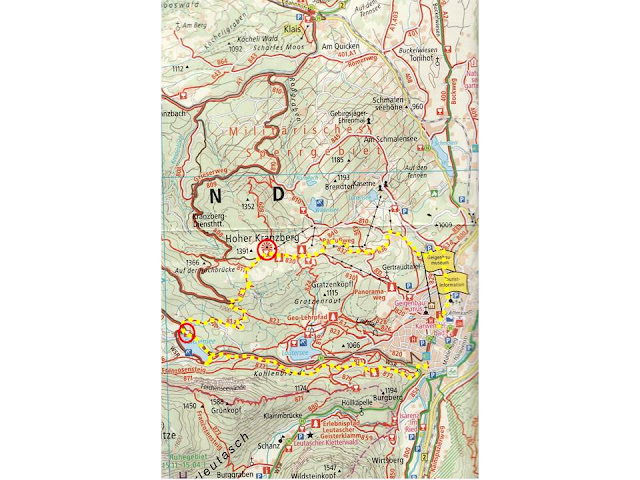 |
| Höhe Kranzberg - Ferchensee - Mittenwald hike |
 |
| Nearing top of Kranzberg (Karwendel range in background). |
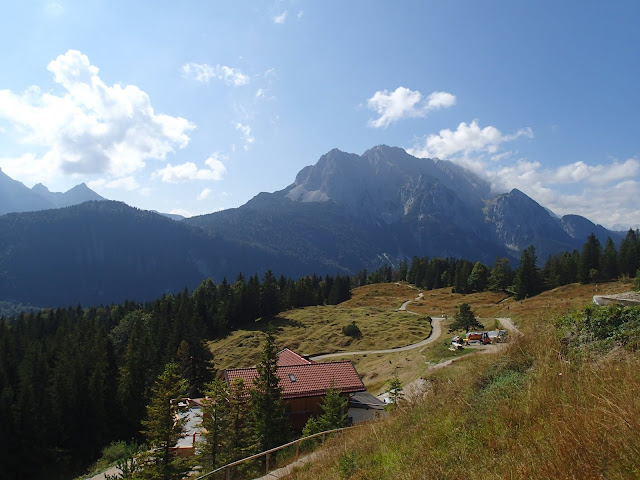 |
| View from top of Höhe Kranzberg (Obere Wettersteinspitze in background) |
Reaching the top of the Kranzberg gave us great view of the surrounding mountains, allowing David to point out all the peaks he had climbed (alone or with friend Ilse) in the past (W. Karwendelspitze, Vierespitze, Wettersteinspitze, etc). Truth is, David was kinda shocked he did all these climbs, many quite exposed, often in one day. Pointing to the Wetterstein, he remarked out loud that "Must have been when I was young and stupid", causing some German tourists nearby to start laughing.
We hiked for about 4 hours on easy trails. Tired at the end, we were happy to enjoy an excellent Jägers Dunkel bier at the Mittenwald brewery.
Our next hike was to be more ambitious. The plan was to hike to the Soiernhaus for the first night, and then to another mountain hut for a second night. David had hiked the Soiern twice in the past.
 |
| Soiern hike |
We took the local bus to Krün, and started hiking. The first 1.5 hours were on a relatively-steep gravel road (restricted so there was no traffic). Arriving at Fischbach Alm (alp), we were faced with a choice. One route David had been on before was indicated to take 30-40 minutes longer than the other. With no warnings about the shorter route, the Lakaiensteig, we chose this faster route. Unfortunately it was not faster for us, as the route had many dangerous dropoffs which caused us to slow down and be extra careful. Nothing technical, but one always had to be cautious and it certainly added tension to the walk. (Reminded us of the first half of our Manaslu trek last year!). Michelle was not happy as we arrived (safely) at the Soiernhaus. "No more dangerous trails!" (Having taken the alternate route previously, David belatedly wished we had taken that safer, albeit longer distance, route.)
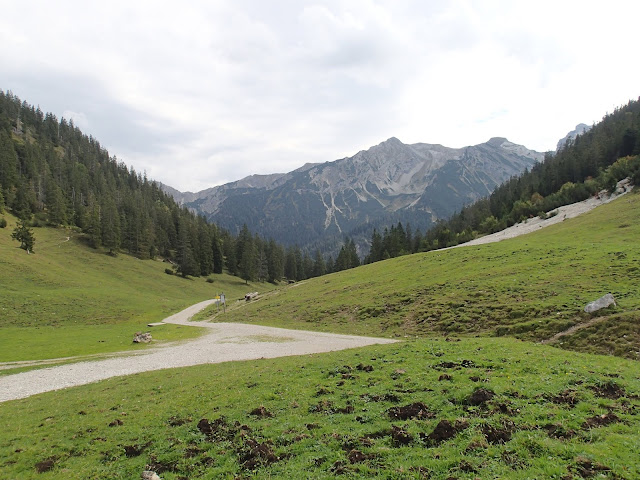 |
| Fischbach Alm: decision time (Which route?) |
 |
| Looking at Soiernhaus (our trail traversed cliffs in centre) |
 |
| Soiernhaus |
We were shown our bunks upstairs in the Soiernhaus (we had reserved by email the day before, but the hut turned out to be only 2/3rds full). Full of school kids... (who were pretty well-behaved;
much better than we have observed on camping trips here in British Columbia) plus a few adults. The Soiernhaus was originally built as a royal hunting lodge in 1866 for King Ludwig II. Now it is owned/run as a full-service (i.e., they provide meals) moutain hut by the "Hochland" division of the German Alpine Society.
We had weinshorle (wine spritzer) and radler (beer and lemon pop) to cool off/recover from the Lakaiensteig hike. For dinner, we ordered pumpkin soup to share and two excellent venison stews, and of course white wine. As we said, full service. Michelle (and David) were feeling better already. (Well, perhaps not "full" service, as we had to clear plates ourselves, and then there are the bunks.) After dinner, we paid our bill: 130 Euros (40 for 2 bunks; 20 for 2 breakfasts; 70 for drinks, wine and dinners) -- C$200 seems rather pricy for 1 night (certainly compared to our Nepal treks)!
Soiernhaus had shiny new bathrooms which you had to go outside to reach (in 1985, the last time David was there, the bathroom was inside the main building and much smaller). No problem, except 30 minutes after we arrived, it started pouring rain. The new bathrooms also do not have hot water (thus no showers). The bunk was a little too short for David and a little claustrophobic. We had brought the required sheet sleeping bags and with supplied blankets, we were not cold.
Talking to the Soiernhaus staff, we learned that the hut we planned to stay the next night had just closed for the season. Given a somewhat poor sleep the night before, the lack of privacy, and the whole feeling of "camping with the kids" (and the lack of showers), and the surprising high cost, we decided to change plans and complete the hike by heading back to Mittenwald. But which way? We could go back the way we came (Nope!); we could take the easier, longer, safer route (But do we want return via Krün?) or we could head towards Mittenwald via one of two possible routes, both of which David had done (1985). One route was longer and rated as a "blue" route (not scary). The other went over the Shöttelkarspitze and had some exposed sections. In 1985, David took Terry his Ph.D. professor over this route to the Soiernhaus, and did not recall any problems (and Terry doesn't love heights). Still, we asked the Soiernhaus staff, who said the Shöttelkarspitze route was fine, and nowhere near as scary as the Lakaiensteig. Another hiker, a British Army guy who trains NATO soldiers in outdoor survival, also said the trail was fine, with only about 300m that were exposed.
The trail started out nicely. Great views, including a large herd of mountain-sheep called "gemsen" (we saw even more gemsen later in the hike). We were surprised to be passed by two young guys who were barefoot hiking (they brought no shoes at all). Strange. Even stranger when they left the trail and tried to climb steep stream beds (which they eventually gave up). One really good cut from the sharp rocks and what would they do?
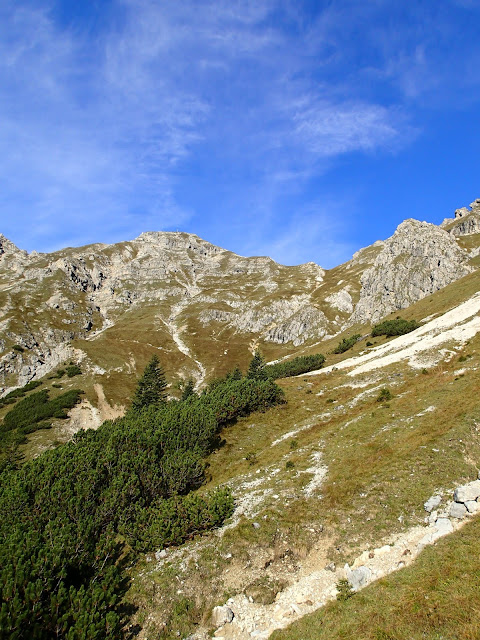 |
| Looking up at out route over the Shöttelkarspitze |
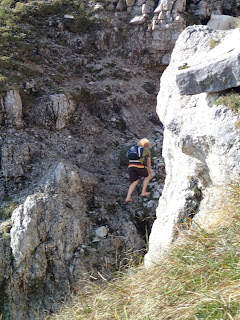 |
| Crazy barefoot hikers (here, off the trail) |
 |
| On the way up to Shöttelkarspitze (zoom in to see herd of "gemsen") |
As we neared the top, the dropoffs became more scary. We nevertheless
took the 5-minute detour to the cross on the top of the
Shöttelkarspitze. As he had done in the 70s and 80s, David filled out an
entry in the logbook that is usually placed in a box on the cross at the top of peaks in
Germany and Austria. Fantastic views. Time for a drink and bite to eat.
But all the time, we kept thinking we still had to get over and down,
safely. Michelle was not happy. (Guess when British Army outdoor survival guy says "only about 300m exposed", we should consider that a warning.)
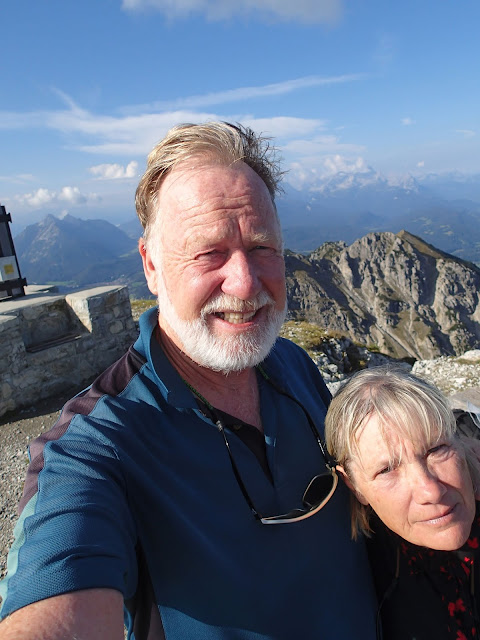 |
| On top of the Shöttelkarspitze |
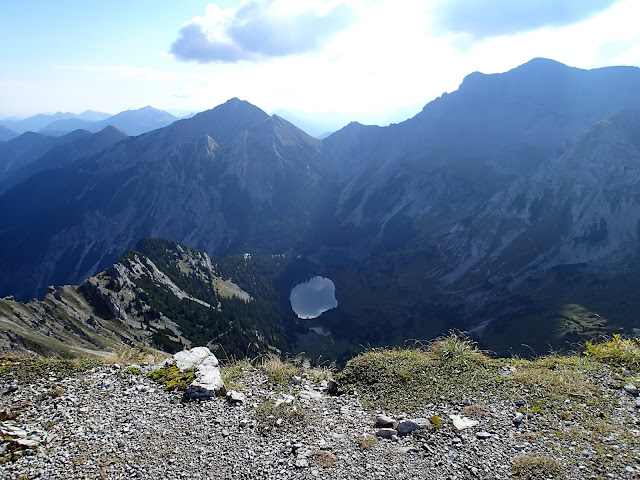 |
| View back down to Soiern See (lake) and to the left of the lake, the Soiernhaus. |
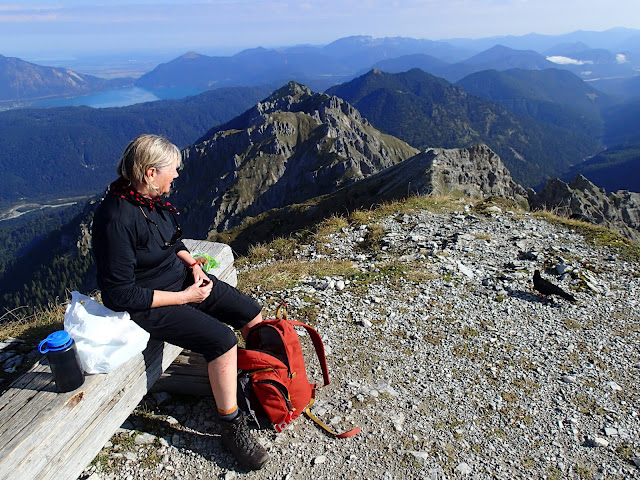 |
| Lunch on top of the Shöttelkarspitze (view towards Wälgau, in direction of Munich) |
Getting back down to the intersection may have only take 5 minutes, but it was scary as any slip and that would be it. David was in trouble....
The rest of the route followed a ridge that looked scary, but fortunately wasn't as bad as it looked (and definitely better than what we had just done). Once the ridge was done (taking perhaps 20 minutes), it then was a non-scary/non-dangerous hike down a rather steep meadow. At the bottom of this, we took a chocolate break and thought about living longer....
 |
| Looking back up to the mountains around the Soiern (including the Shöttelkarspitze) from Mittenwald |
We then had a choice: go down a gravel road to a bus stop, requiring about another 45 minutes walk( but not being sure if/when bus would come), or keep walking all the way
to Mittenwald (on easy, nearly-flat paths) requiring two hours. We
chose the latter. We arrived back in Mittenwald very hot and tired. We
went to our hotel (we had phoned for a room, and were directed to the
posh "Post Hotel" for 1 night), had a shower, then headed to the Mittenwald Brewery for much anticipated Jägers Dunkel biers!
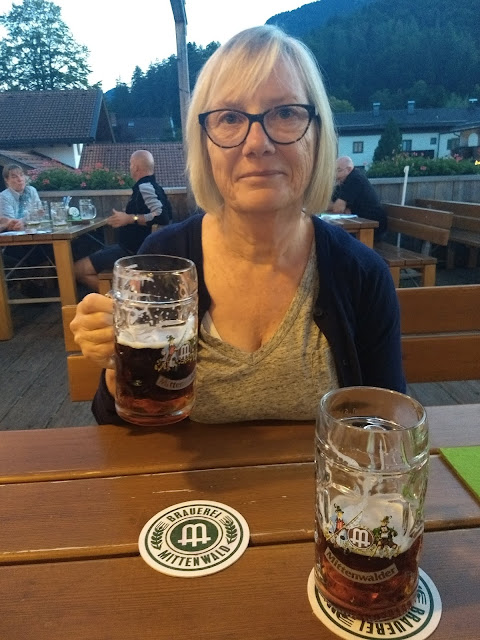 |
| The first of the MUCH anticipated Jägers Dunkel biers at the Mittenwald Brewery (yes, she is smiling) |
After our Soiern hike, we stayed two nights in Mittenwald (moving back to the Alpenrose on the second night). We ate and drank very well. We also had a gentle enjoyable hike in the Leutasch Klamm (a very narrow deep gorge with a metal walkway along it) which is in Austria but exits in Germany, even stopping for weinshorle and radler at the Gletscherschliff Restaurant on the way back down.
 |
| Leutasch Klamm |
After Mittenwald, we took the train to
Oberammergau. Our gästhaus was a 15-minute walk out of town (we knew this in advance), and it was beautiful. That night we had our best meal of the trip (and we'd had many excellent meals in Germany) at the
Gästhof-hotel Zur Rose. (So good, we returned the next evening for dinner.).
On our second day, we decided to go hiking again. This time, we promised, no crazy dropoffs. After talking with our lodge host, we headed around the back of the Läber, with the intention of reaching the top (where the Läberbergbahn cable car goes to), have lunch, then come back down via Ettal.
We never made it to Ettal. There was some confusion over which trail to take, and we ended getting near the top, then detouring on a nice road around to the
front of the Läber, where we were confronted by a trail sign indicating we were at the Läbersteig which was "Nür fur Geüpte" -- only for experienced. Well, we were "experienced", but we didn't want to go on another dicey trail. So we decided to follow it up until we became uncomfortable. Up top, the fog had rolled in, and we made it very close to the top (the Schartenkopf) before we decided to turn back -- it was starting to get dicey. By the time we got back down to the bottom (taking the Läbersteig all the way down), the fog cleared and we could see the top; it didn't look so bad and we realized we had come close to the top. Oh well, better safe and happy.
 |
| Only for experienced... |
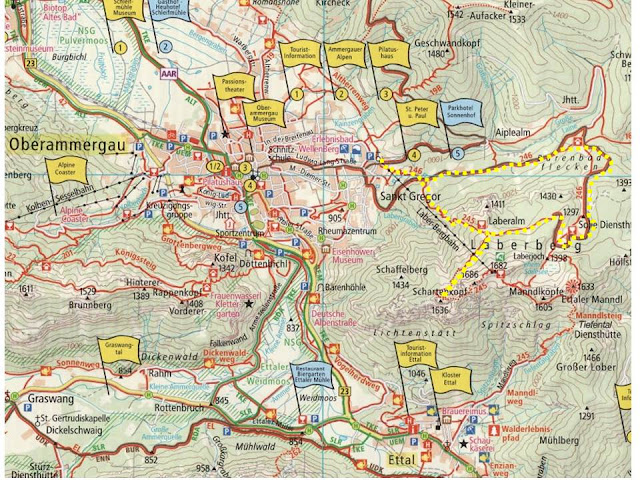 |
| Oberammergau and the Läber hike |
 |
| Läber (mound on the top left) and Schartenkopf (ridge on top right; we made it to just below this) |
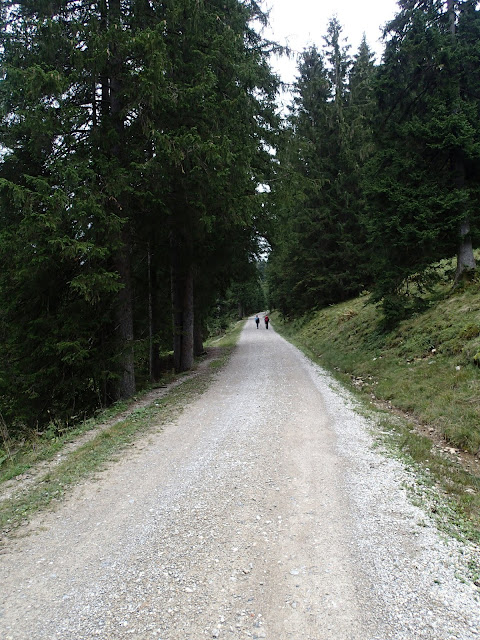 |
| Easy walking up the back of the Läber |
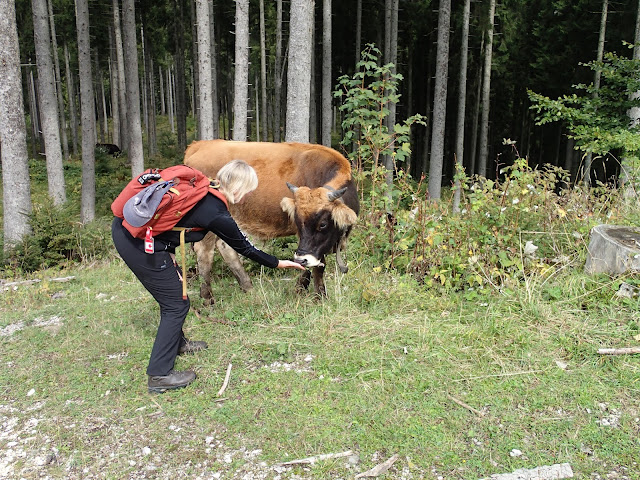 |
| Michelle gets her cow time... |
 |
| Lots of cow time... |
 |
| Friendly but persistent horses who liked apples |
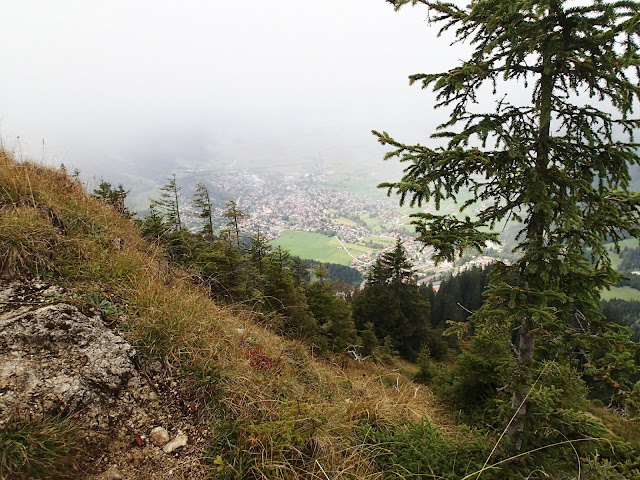 |
| On the Läbersteig, as it is getting steeper (Oberammergau straight down below) |
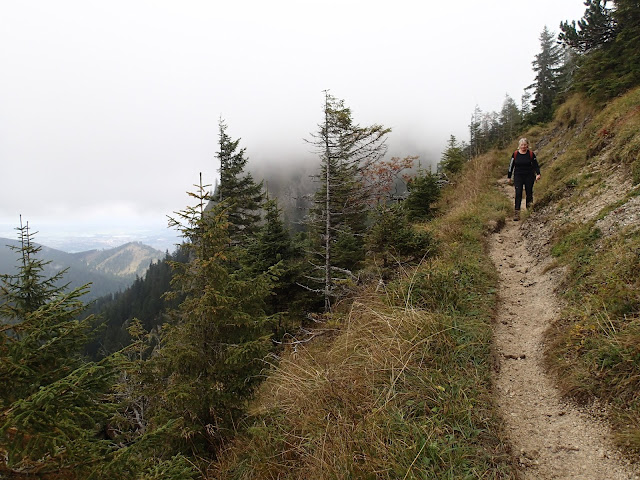 |
| After deciding to turn around (due to fog and steep dropoffs) |
We enjoyed Oberammergau. We'd be happy to return and try some other hikes. But we were scheduled to head up to Augsburg (2-3 hours by train).
Augsburg was new to both of us, and we both liked it very much. A very manageable city, with a beautiful old downtown core. Not at all overrun by tourists (indeed, we saw few tourists).
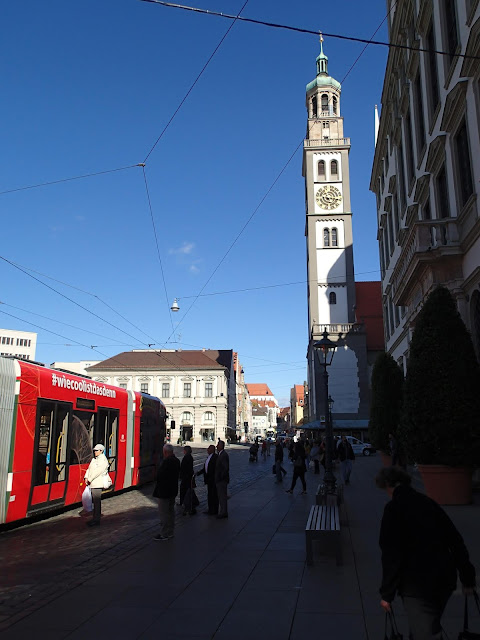 |
| Augsburg City Hall and Perlach Tower |
One reason we chose Augsburg was that it was close to Munich (<50 minutes by train) without the outrageous prices charged by Munich hotels during Octoberfest. David has been to Munich many times (70s-80s), but never to Octoberfest. As we were discover, Octoberfest might have been more enjoyable when he/we were younger....
Arriving at the main train station in
Munich, we were taken aback by the hordes of tourists. We headed over to Marienplatz, where we arrived minutes before the 12 noon "performance" of the glockenspiel in the New Town Hall (
Neues Rathaus). Seemed like thousands of tourists were clicking photos of the glockenspiel (only a movie can do it justice).
 |
| Neues Rathaus and its Glockenspiel |
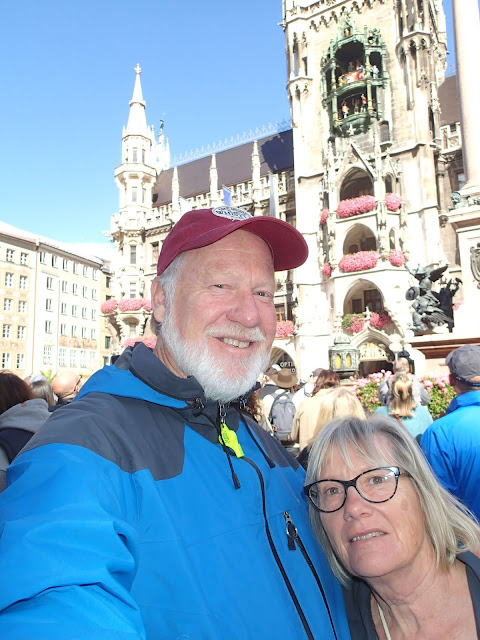 |
| The required selfie |
David wanted to go to Marienplatz so we could have lunch (and beer!) in his old favourite, the
Schneider Weißes Bräuhaus. The Weissbier was still wonderful, and the würst was, well, as good as würst can be. Their apfel strudel was wonderful. However, what had really changed since the 70-80s, is that the Schneider Weißes Bräuhaus is now firmly on the tourist map, with many American and Japanese tourists.
 |
| Schneider Weißes Bräuhaus |
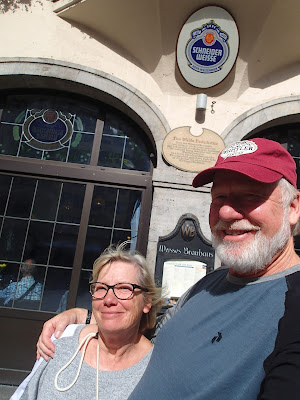 |
| Yup, another selfie |
We decided it was time to head over to
Octoberfest. Hopefully before it became too crowded. Arriving at the Octoberfest's "midway", we were impressed by what seemed the scariest rides we had ever seen. Certainly too much for us (or, at least, David...). In our mind, many rides were "Nür fur Geüpte".
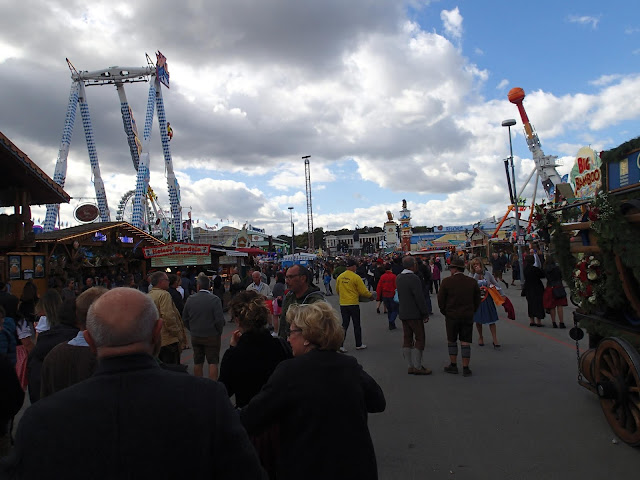 |
| Octoberfest "midway" |
 |
| In our mind, the scariest ride at Octoberfest |
We checked out some beer tents. Some were pumping out music while others were quiet. (We had heard that music plays for shorter periods during the daytime.) The tables were all full and none seemed inviting.
 |
| Inside an Octoberfest tent (Palaner?) at about 3pm on a Monday |
We finally found a spot at a table in the Schottenhamel Tent. As it turned out, the man alone at the table was very (
very) drunk and unintelligble. When his two friends returned to the table, they were "surprised" to see us there. We tried to have a conversation, but between language difficulties and their inebriated state, it seemed hopeless. Meanwhile, we had tried numerous times to get a beer (each time, the waitperson said something like "ask my colleague"). In the end, we were glad we didn't get a beer, as it only came in 1-litre steins (ein maß) and only boring "Helles" beer. And we were not enjoying our tablemates nor did we appreciate the
many drunks (including many many non-German tourists all dressed up in their "trachten" -- lederhosen for men and dirndl for women). We got out of there. Perhaps we would have enjoyed Octoberfest more when we were 20-30 years of age.
 |
| A part of Octoberfest Michelle loved: the horses |
 |
| Hőfbräu Horses (Hőfbräu is pronouced "hoaf " or "hoof" "broy", NOT "hofbrow" ) |
After getting away from Octoberfest, we tried to do some sightseeing. But the crowds of people (both locals and tourists) were overwhelming to us. We decided to make a hasty retreat back to Augsburg.
It was a real relief to get off the train in Augsburg. We headed straight over to the
Riegele Brewery for great beer and a light meal (we were still a little full from our lunch at Schneider Weiße).
We spent our last day in Germany exploring Augsburg. Its a lovely place.
 |
| Weberhaus, Augsburg |
 |
| Relaxed Augsburg |
On the last morning we caught our ICE express train to Frankfurt Airport, where we learned our airline had changed our flight. That's another story for another time.

